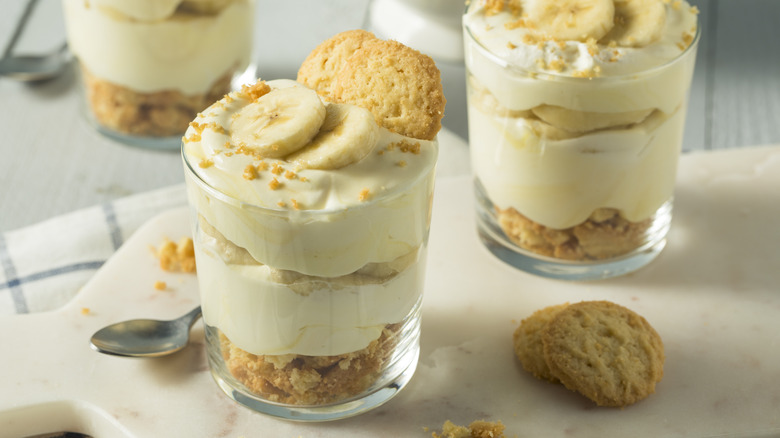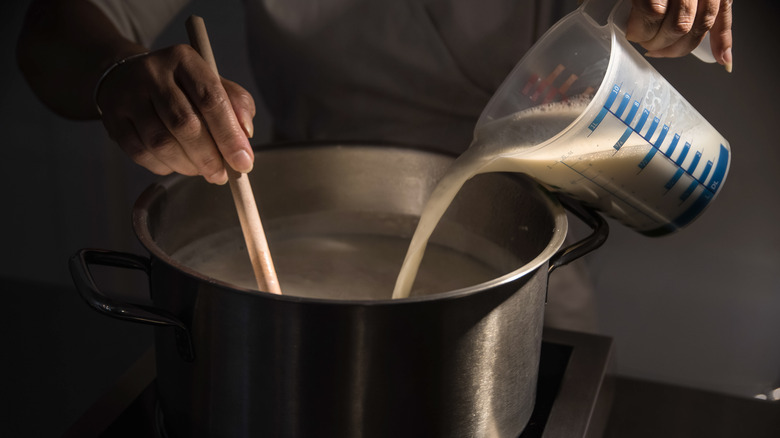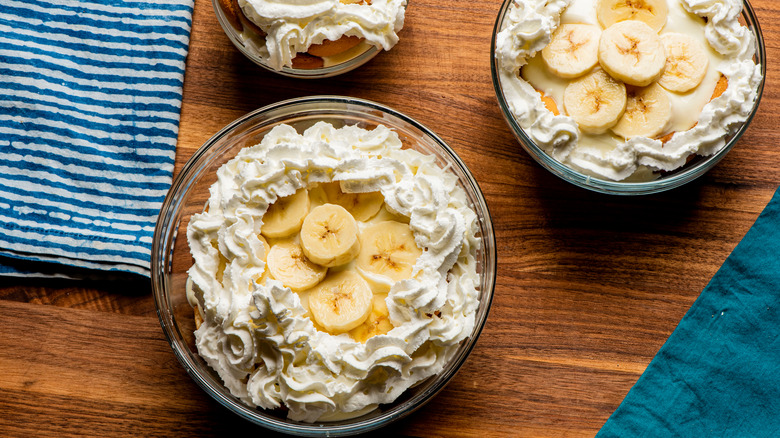The Obscure Origins Of Southern Banana Pudding
Banana pudding might not be the most popular item on the menu these days, but there's no reason why it shouldn't be. If you have a sweet tooth and want to try it for yourself, put some vanilla pudding in a Mason jar layered with bananas and vanilla wafer cookies, and you've got a satisfying treat that will have you feeling like you're lounging on a porch swing in the Louisiana sunshine.
Banana pudding may feel like the quintessential southern dessert, but is it? The pudding certainly became a popular dish in the southern states, perhaps because of ports like New Orleans and their proximity to banana growing regions in the mid-1800s, making the banana an accessible fruit for Americans. But as it turns out, the first recipes for the dish weren't found in the South at all. Instead, the first recorded mentions of any such cuisine were actually found much further north. The truth about how banana pudding became a quintessential delight below the Mason-Dixon line is obscure, but food historians have done their best to trace the origins of this classic dessert.
A tasty spin on the English trifle
While today you can make banana pudding easily using bananas and an instant pudding mix, the dessert was initially fashioned after the popular English trifle, which is a dessert of layered custard, fruit, sponge cake, and whipped cream. Banana pudding was traditionally made in the same way, using sliced bananas.
The very first record of a recipe for banana pudding didn't come from the South, though. According to food historian Robert Moss, writing for Serious Eats, the first known mention of a recipe was found in the "Information Wanted" section of The New York Times in 1878, with an entry reading, "A receipt for frozen banana pudding." The first official recipe was printed 10 years later in Good Housekeeping, another Northern publication out of Massachusetts, calling for chilled custard to be layered with sliced bananas and sponge cake.
Methods of making banana pudding are pretty similar today, although the invention of the vanilla wafer cookie in the early 1900s changed the traditional sponge cake layer to one of store-bought cookies. In 1921, a banana pudding recipe was printed in the Illinois publication, Pantagraph, which called for an entire pound of the cookies. Soon after, Nabisco began printing a recipe on its boxes of vanilla wafers, later known as Nilla Wafers.
The rising popularity of bananas in the 1860s, especially in the South
Before the Civil War, bananas were rare commodities in the United States. The few that were available were imported from the West Indies and brought to some ports on the Eastern seaboard. But after the Civil War in the 1860s, new traders and faster steam ships appeared on the scene, meaning that suddenly bananas became accessible and affordable as they arrived from the Caribbean and Central America. And with the simultaneous growth of the railroad system, bananas were being shipped to all part of the country. With this influx of the fruit, it became a common addition to dishes and desserts.
With that in mind, there's no other real reason that the South should be so closely associated with banana pudding. However, by the mid-20th century, newspapers were publishing recipes that associated the dessert with the South, with article headlines such as, "Deep South's Banana Pudding Tasty Treat." By that point, banana pudding was widely considered to be a southern dish through and through. According to speculation by food writers and historians like Robert Moss for Serious Eats, this may be because banana pudding was an easy, chilly treat that offered a respite from the South's excruciating heat. It also made a wonderful crowd-pleaser for family reunions and large gatherings that were popular across the South. While we might never truly know how it came to be, at least we can all still enjoy this southern treat.



